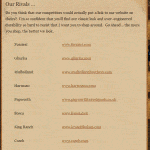Was it the Google Ad that turned them from a prospect into your next health club member? Maybe it was that special-offer email. Or that Facebook post. No, wait: it was probably the Facebook ad! Or maybe that amazing blog post on the benefits of exercise (probably not).
You’re spending time and money on all these channels, right?
But do you know which ones actually work for your specific wellness business? And even more importantly, which ones have the best ROI?
Some of you are thinking, “Hey, I know this answer. We’ve got our front desk staff trained to always, ALWAYS ask “How did you hear about us?”
Guess what: you can stop doing that. The answers are nearly always misleading and lead directly to bad business decisions.
Here’s what prospects really do.
If your customer gave you an accurate description of how she found your club, it would sound a lot like this:
I Googled ‘women’s health center.’
(Channel: organic Google search)
Then I clicked on an ad.
(Channel: organic Google search. In reality, she clicked on a free Google-constructed list of potentially relevant businesses, but she doesn’t know that even happens, so she doesn’t describe it that way.)
I didn’t like that website so I searched again.
(Channel: organic Google search)
This time I saw a different website, but before I could look, I had to go to work.
(Channel: organic Google search)
Later that week I saw an ad for that website pop up in my Facebook feed. I clicked on it.
(Channel: social, thanks to a remarketing campaign!)
The name stuck with me so the next day at lunch, I typed in part of the name and saw another ad. I clicked on it and it looked interesting but I was super-busy, so I signed up for the newsletter so I’d be reminded that these guys looked good.
(Channel: Google Ads pay per click)
The next week I got one of their emails which reminded me that I still wanted to see about an appointment so I went back to their website and tapped their phone number but then the traffic light changed before anyone answered and I had to hang up.
(Channel: direct)
A couple days later I got a newsletter with an invitation to a free panel discussion on bioidentical hormones. I clicked on a link.
(Channel: email)
I couldn’t go to that, but I pulled them up in Google and hit the message button (on their Google My Business knowledge panel) and texted them to set up an appointment.
(Channel: organic)
Yet I guarantee you her answer to “How did you hear about us?” is something like:
“A friend.”
“Online.”
Or something else equally simplistic and misleading. Maybe she mentions the last thing she did. Or the first thing. Or she kinda sorta thinks she saw a billboard. Or, or, or. Consumers are notoriously inaccurate self-reporters on this stuff.
Jumping between channels is normal.
These days, it’s normal for folks to jump back and forth between marketing channels (plus their desktop and mobile!) before they turn into paying customers.
Sometimes, it’s because they’re still gathering information.
Sometimes, it’s just a matter of convenience.
Sometimes, it reflects their urgency (fewer jumps) or their skepticism and anxiety (more jumps), especially as price and the complexity of the problem and solution go up (more jumps).
We’ve seen addiction prospects who do a single Google search and immediately call or text. We’ve had sports injury rehab and pain management clients whose prospects jump between just a couple of channels just 2-3 times before making an appointment.
In many markets, it’s not unusual to see health club prospects in their 20s and early 30s follow up with a free tour or trial membership after one or two Google Ad clicks, a glance at Google My Business reviews and a fast website visit to check out prices and childcare availability.
Yet consumers in their 40s and 50s might check out your social ad multiple times, take a peek at your Facebook page, poke around on your website for 10 minutes, read numerous reviews from Yelp, Facebook and Google My Business, click on your Google Ad and so on.
In fact, we’ve seen weight loss, women’s health and chronic disease management businesses whose prospects routinely interact with their business 7-10 times, across every available channel, before making first contact!
There are no “rules of thumb.” There are no right or wrong answers.
Every business is different.
As a result, clients often wonder, “Does that mean we have to be in every channel?”
Maybe. Maybe not. The answer lies in data that’s available to you, but nearly always underutilized.
Every business has a “happy path.”
The “happy path” is the shortest distance between two points that generates the best available ROI.
In this case, it’s the quickest path between a prospect’s initial interest and their final decision to become your client, patient or member.
Every business has a different happy path. Your yoga studio’s happy path will be different from that Bikram studio across town.
To make smart decisions, you need to know the happy path for your specific business, based on your own sales and marketing data.
For example:
If you know that the happy path in your business is a Google Ads click followed by a return site visit within 48 hours followed by a phone call off your site or a text via Google My Business to schedule an initial physician consult, would it be smarter to:
- Invest in a weekly newsletter
- Make sure every phone call is answered by the second ring
- Respond to every text within 3 minutes
- Publish more posts on your Facebook business page
- Publish more blog posts on your website
- Run awareness-oriented Facebook or Instagram ads
- Hire someone to make sure you get listed in every web directory available
- Spend money on a newspaper or local shopper ad
If I’m the owner, I’m for sure going to make sure #2 and #3 happen as long as the additional revenue is more than the additional cost.
If I had some extra budget to experiment with, I might test some awareness ads on social. My hypothesis would be that I might be able to reduce my Google Ads cost/conversion by increasing the likelihood that more prospects would go directly to my website. To be clear, though—I’d be looking very closely at the Facebook ad results to see if this hypothesis really proved out.
The rest of this stuff—it’s highly unlikely to improve the happy path, so I’m not going to do any of it.
How do you figure out your “happy path”?
The good news is that all the data you need is already generated by the marketing and billing platforms you’re already using. You don’t have to pay these vendors extra to get your data. You just have to put it to work for you.
Here’s the process we go through for our wellness business dashboard clients.
You can follow a similar process for the specific channels your health and wellness businesses uses:
- Make a list of all the significant marketing platforms you’re using—platforms like Google Ads, Google Analytics, Google My Business, Facebook, Instagram, Yelp, Unbounce, Hubspot, and your email marketing platform. Include Google Tag Manager.
- List any significant referral partners, like PsychologyToday.com’s referral portal or Acufinder for acupuncturists.
- List your major e-commerce or customer management and billing systems, like MindBody or Vagaro or another studio, practice or club management software platform.
- Determine the most important call-to-action, goal and conversion touchpoints that should be tracked across all these platforms
- For each platform you identify, configure all the options and advanced settings to help capture this data or other relevant data dimensions so that you can actually use this information for marketing analysis.
For example, use Google Tag Manager to help you track non-link-click events like calls and form interactions. Make sure GCLID tracking is turned on in Google Ads and configure UTM tracking codes for all of your locations. Define strategic goal completions in Google Analytics.
6. Connect each platform to your reporting dashboard.
7. Configure the dashboard for each metric you need to track.
Once these building blocks are in place, you’ve got all the data you need to uncover the “happy path” that most efficiently and effectively transforms prospects into paying customers.
You can model your sales funnel with real data and analyze the movement of leads through all of these channels as they become a paying customer.
Even better, you can predict with much greater reliability how increases or decreases in specific marketing investments are likely to affect your revenue, customer and profit growth.
Why guess at what works, when you can harness data that shows you where your marketing time and dollars are paying off?



